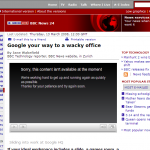I’m sure other people will have much better insight than I into the departure of Ashley Highfield from his £359,000/year job at the BBC. Of course, he’s moving to a not-unrelated position, heading up Project Kangaroo, the video-on-demand joint-venture between the BBC, ITV and Channel Four. The success of iPlayer version 2 may or may not have been a factor… but isn’t it interesting how version 1 has become a dim and distant memory already been wiped from the history books? (See below.)
The Guardian reckons Erik Huggers has been groomed to be his successor:
“There’s a belief that [Huggers] was brought in specially and was being trained up for the job,” said (an) insider, who added that Huggers was well respected within the corporation. He makes stuff happen and is very hands-on. He is a very accomplished public speaker, has a very broad knowledge and will knock heads together.”
The source also said Huggers may find it difficult to move from a very delivery-focused, practical role to the politics of the corporation’s top digital media job. “Ashley’s job is 85% politics, 15% doing things. It will be interesting to see how [Huggers] does.”
Interesting use of the word ‘interesting’ there, obviously.
I suppose it’s a high-profile vote of confidence in the internet as a medium for distributing TV, although it makes the recent spat between Highfield and the country’s ISPs all the more juicy. And it’s probably a good thing for the BBC to have a new hand at the helm.
Update…
Over on the BBC’s Internet blog, Nick Reynolds posts the full email to staff from Mark Thompson. (Thanks Nick.) Again, I note the prominent iPlayer reference. It’s amazing how this has become a great moment in UK media history, despite getting it (frankly) so wrong in its first incarnation.
But hang on. I’m most amused by Thompson’s line about iPlayer receiving ’42 million programme requests in its first three months’. This figure seems to come from a press release last week, which proclaimed 42 million ‘in the first three months since its Christmas Day 2007 marketing launch‘. Crucially then, it seems we’re wiping the Microsoft-only, Kontiki-based, wait-forever-to-download product from the history books. Better remove all trace from the archives, guys.
And for the record, has anyone managed successfully to watch programming on a Wii? I’m finding it stops every 20-30 seconds to buffer, making it practically unwatchable.

